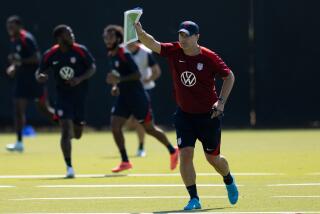Rich Legacies Left Behind by Matthews, Morejon
Soccer lost two of its true gentlemen in the last 10 days, one whose name was known and loved worldwide, the other whose fame was confined to Southern California.
The deaths of Sir Stanley Matthews in England and Tony Morejon in San Pedro have deprived the sport of men who each spent the better part of half a century raising its stature.
That one did so globally and the other locally in no way detracts from the achievements of either. They shared a deep love of the game and dedicated their lives to it.
Tributes to Matthews, who died Wednesday at 85, have come from around the world. A minute’s silence is being observed in his honor at all soccer games in England this weekend.
“Sir Stanley was and will always remain one of the all-time sporting greats,” said British Prime Minister Tony Blair.
“He was not only one of the finest players this country has ever seen, he was also a model sportsman who played the game as it should be played, never booked or sent off once. Football fans everywhere have lost one of their heroes.”
The tributes to Morejon, who died Feb. 18 at 79, were delivered at his funeral in Rancho Palos Verdes on Wednesday by friends and colleagues who had been charmed by the gravel-voiced Spaniard during the more than 50 years he helped build the sport in Los Angeles as a player, coach and promoter.
It is doubtful--but not inconceivable--that the paths of the two men ever crossed. But Morejon, like every other soccer fan on the planet, certainly would have known every detail of the playing career of the man known worldwide as “the Wizard of Dribble.”
Matthews, the son of a barber and part-time boxer, was only 14 when he joined the Stoke City club in 1929, sweeping locker rooms and cleaning boots for three years before making his professional debut as a 17-year-old in March 1932.
Thirty-three years later, in February 1965, when he was 50, he played his last professional game. He had spent his entire career with only two clubs, Stoke and Blackpool.
With Blackpool in 1953, he engineered an improbable comeback, helping turn a 3-1 deficit into a 4-3 victory in the F.A. Cup Final at Wembley in a game that ever since has been known as “the Matthews Final.”
He played 54 times for England and, in 1956 at 41, became the first man named European footballer of the year. In 1965, he became the first soccer player knighted by Queen Elizabeth II, “for services to the game.”
Another soccer knight is in Los Angeles this weekend for Sunday’s Gold Cup final at the Coliseum. Sir Bobby Charlton joined the rest of the world in paying tribute to Matthews.
“People just had to go and see him,” Charlton said. “Everybody over 50 will remember Stanley Matthews as an absolute genius.”
Indeed, long before Pele or Franz Beckenbauer or Johan Cruyff or George Best or Diego Maradona became household names, Matthews’ fame was global.
Said French national team Coach Roger Lemerre: “I consider Matthews on the same level as Pele.”
In Matthews’ hometown of Hanley, near Stoke, flowers adorn the life-size bronze statue that was raised in his honor in the town square in 1987. The inscription, in part, reads as follows:
“His name is symbolic of the beauty of the game, his fame tireless and international, his sportsmanship and modesty universally acclaimed. A magical player, of the people, for the people.”
Los Angeles will raise no statues to Morejon. But San Pedro could do worse than rename Daniels Field in his honor. Morejon spent much of his life caring for the small soccer stadium by the sea.
And in Oneonta, N.Y., the folks at the national Soccer Hall of Fame might dust off the old news clippings and check the record books and consider just how much one man meant to one sport in one city.
Surely there is a place for those with a lifetime’s accomplishment at the grass-roots level, just as there is for those whose feats carry their fame worldwide.
WORLD CUP 2006
Among those who will not be on hand in Los Angeles today to greet FIFA President Joseph “Sepp” Blatter when he arrives for the Gold Cup final will be Alan Rothenberg. The former president of U.S. Soccer is completing a five-day visit to Morocco as head of FIFA’s World Cup 2006 inspection committee.
Morocco is one of five nations, along with Brazil, England, Germany and South Africa, bidding to host the 2006 tournament.
“We are here to learn all about the Moroccan bid, meet the officials and see how passionate Moroccans are for organizing the Cup--from the most simple Moroccan to the Royal Palace,” Rothenberg was quoted as saying.
Morocco has pledged to spend $560 million to upgrade sports facilities and modernize its infrastructure in the hope of winning the bid.
Rothenberg’s committee still must visit South Africa before making its recommendation to FIFA, whose executive committee will vote in Zurich, Switzerland, on July 5 and 6.
England is the favorite at the moment. If that country does turn out to be FIFA’s choice, world soccer’s ruling body can expect an unholy protest from the snubbed African countries.
That can be avoided, or at least lessened, by awarding South Africa the FIFA Confederations Cup in, say, 2003, and giving Morocco the next FIFA World Club Championship.
Neither competition is the World Cup, but they will serve to help the South Africans and Moroccans gauge whether they really are able to stage soccer’s biggest event.
Judging by the shambles Nigeria and the Confederation of African Football (CAF) made of the recent African Nations Cup, it is doubtful that the continent is ready.
Africa turns out fine players and fine teams--Nigeria is the reigning Olympic champion, for example--but its soccer federations are typically run by incompetent and often corrupt amateurs.
MLS FUTURE
Sooner or later, there will come an almighty clash between MLS and U.S. Soccer.
The issue will come down to just what the league’s mission is supposed to be. Is MLS here to develop players for the U.S. national team or is it a business?
If helping to make the U.S. a stronger soccer nation is its goal, MLS will fail as a business. The league cannot survive on a steady diet of American-born and bred players. There are not enough good ones to make it work.
If, on the other hand, MLS is a business, the simple way to fill stadiums from coast to coast would be to scrap the U.S. Soccer-imposed limit on foreign players--four this season--and sign the best players affordable, regardless of nationality.
When Phil Anschutz, Robert Kraft, Lamar Hunt and the rest of the league’s “investor-operators” awake to this possibility, fireworks could erupt.
If MLS is willing to go to court on the issue, there is nothing U.S. Soccer or FIFA can do to stop it. After all, if Chelsea in the English Premier League can field a team without a single Englishman, what’s to stop the Galaxy from fielding a team without a single American?
Nothing, legally. It’s all simply based on tradition and FIFA’s long-held but increasingly challenged grip on the game.
One compromise: Leave all leagues in the CONCACAF region, including MLS, free to sign as many foreign players as they like, as long as they are from CONCACAF countries.
That would boost the leagues and help CONCACAF grow at the same time.
It beats a costly and protracted lawsuit and it certainly beats seeing MLS fold simply because it isn’t allowed to put the best product on the field.
QUICK PASSES
UCLA women’s Coach Jillian Ellis has been named coach of the U.S. under-21 women’s national team. Former Stanford and now Virginia Coach Steve Swanson will take charge of the U.S. under-18 women’s national team, and 1991 Women’s World Cup champion Tracey Bates Leone has been selected to coach the under-16 women’s national team. All three appointments were made by U.S. women’s national team Coach April Heinrichs. . . . Having failed to reach agreement with Univision, specifically over the Spanish network’s demand that it be allowed to televise the championship final along with ABC, MLS has reached agreement with Telemundo to televise 16 league games this season. No playoff plans were announced.






